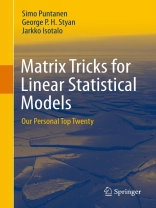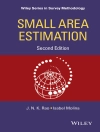In teaching linear statistical models to first-year graduate students or to final-year undergraduate students there is no way to proceed smoothly without matrices and related concepts of linear algebra; their use is really essential. Our experience is that making some particular matrix tricks very familiar to students can substantially increase their insight into linear statistical models (and also multivariate statistical analysis). In matrix algebra, there are handy, sometimes even very simple “tricks” which simplify and clarify the treatment of a problem—both for the student and for the professor. Of course, the concept of a
trick is not uniquely defined—by a trick we simply mean here a useful important handy result.
In this book we collect together our Top Twenty favourite matrix tricks for linear statistical models.
Cuprins
Introduction.- Easy Column Space Tricks.- Easy Projector Tricks.- Easy Correlation Tricks.- Generalized Inverses in a Nutshell.- Rank of the Partitioned Matrix and the Matrix Product.- Rank Cancellation Rule.- Sum of Orthogonal Projector.- Minimizing cov(y – Fx).- BLUE.- General Solution to AYB = C.- Invariance with Respect to the Choice of Generalized Inverse.- Block-Diagonalization and the Schur Complement.- Nonnegative Definiteness of a Partitioned Matrix.- The Matrix M.- Disjointness of Column Spaces.- Full Rank Decomposition.- Eigenvalue Decomposition.- Singular Value Decomposition.- The Cauchy-Schwarz Inequality.- Notation.- References.- Author Index.- Subject Index.
Despre autor
Simo Puntanen earned his Ph D in statistics from the University of Tampere (Tampere, Finland) in 1987, where he is now a Docent and Lecturer of Statistics. He has published over 110 research papers in matrix methods for statistics with particular emphasis on linear statistical models. He is currently the book review editor of the International Statistical Review.
George P. H. Styan earned his Ph D in mathematical statistics from Columbia University in 1969 and received an Honorary Ph D from the University of Tampere in 2000. He is now Professor Emeritus of Mathematics and Statistics at Mc Gill University in Montreal, Canada. He has published over 140 research papers, mostly in matrix methods for statistics, and since 2005, his main interests have focused on magic squares, and mathematical and statistical philately.
Jarkko Isotalo earned his Ph D in statistics from the University of Tampere (Tampere, Finland) in 2007, where he is now a Lecturer of Statistics. His main research interests have been linear statistical models, matrix methods for statistics, and computational statistics. He is currently also doing applied research on statistical genetics.
Puntanen, Styan, and Isotalo, knowing just what is expected of authors, would like to agree with P. G. Wodehouse and apologize for childhoods that were as normal as rice-pudding and lives that consisted of little more than sitting in front of the laptop and cursing a bit.












